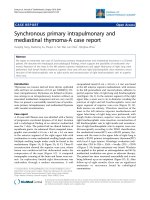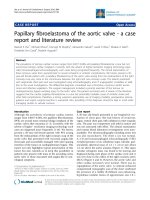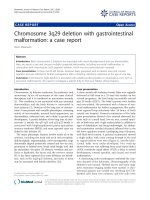Báo cáo y học: " Delayed involution of lactation presenting as a non-resolving breast mass: a case report" pps
Bạn đang xem bản rút gọn của tài liệu. Xem và tải ngay bản đầy đủ của tài liệu tại đây (1.3 MB, 5 trang )
BioMed Central
Page 1 of 5
(page number not for citation purposes)
Journal of Medical Case Reports
Open Access
Case report
Delayed involution of lactation presenting as a non-resolving breast
mass: a case report
Yashwant Kumar
1
, Alka Chahal
1
, Monika Garg
1
, Alka Bhatia*
1
, NC Mahajan
1
and Anil Ganju
2
Address:
1
Department of Pathology, Maharshi Markandeshwar Institute of Medical Sciences and Research, Mullana, Ambala Haryana, India and
2
Department of General Surgery, Maharshi Markandeshwar Institute of Medical Sciences and Research, Mullana, Ambala Haryana, India
Email: Yashwant Kumar - ; Alka Chahal - ; Monika Garg - ;
Alka Bhatia* - ; NC Mahajan - ; Anil Ganju -
* Corresponding author
Abstract
Introduction: Involution of lactation is a physiological process. Rarely, it may be delayed and
troublesome for the lactating woman. Though lactation-induced changes in breast are well known,
morphological features of delayed involution are not clear.
Case presentation: We report a case of a 22-year-old lactating mother who presented with a
painful, non-resolving breast mass 5 months after delivery. Clinically, it simulated an inflammatory
carcinoma. Histopathology, however, revealed involuting lactational changes.
Conclusion: To the best of our knowledge, lactational involution with such a presentation has not
been described in the English literature. The case needs to be reported so that this entity can be
considered among the differential diagnoses of breast masses in a lactating patient.
Introduction
The sequence of events involved in lactation and its invo-
lution have been well studied in animals but the data in
humans are scanty [1]. The involution of lactation is a
process by which a fully functional, lactating mammary
gland regresses to a quiescent, resting stage. This process
of involution is a multistage process [2], usually begins
after 3 months of lactation and is symptomless [3]. It
begins with the onset of cessation of milk secretion, dur-
ing which the acinar cells lose their differentiated pheno-
type. This is followed by collapse of the acini with
apoptosis of acinar cells and clearance of residual milk by
the phagocytes. Finally, there is re-growth of the stromal
adipose tissue resulting in morphology similar to the
postpubertal nonlactating gland. Rarely, the process of
involution may be delayed and failure to remove unnec-
essary lactational acini may result in symptomatic inflam-
matory tissue damage. The morphological features of
delayed involution are not clearly defined. To the best of
our knowledge, this is the first report describing the mor-
phology of delayed lactational involution which pre-
sented as a non-resolving breast mass.
Case presentation
A 22-year-old woman who was 5 months postpartum pre-
sented with a left-sided breast lump of 3 months duration.
The lump was associated with pain and tenderness. For
the last 15 days, she had also developed retraction of nip-
ple along with thick nipple discharge. This was her first
pregnancy and she could not feed her child on this side.
Published: 13 October 2008
Journal of Medical Case Reports 2008, 2:327 doi:10.1186/1752-1947-2-327
Received: 2 January 2008
Accepted: 13 October 2008
This article is available from: />© 2008 Kumar et al; licensee BioMed Central Ltd.
This is an Open Access article distributed under the terms of the Creative Commons Attribution License ( />),
which permits unrestricted use, distribution, and reproduction in any medium, provided the original work is properly cited.
Journal of Medical Case Reports 2008, 2:327 />Page 2 of 5
(page number not for citation purposes)
There was no history of fever or trauma to the breast. On
examination, her left breast was grossly enlarged with red
and inflamed overlying skin. The nipple-areola complex
was markedly enlarged with hyperpigmentation of areola
but there was no excoriation. Thick discharge was seen on
the nipple. On palpation, a large, multinodular, tender
lump of about 6.0 × 5.0 × 2.4 cm was felt in the upper and
outer quadrant. The lump was firm to hard in consistency.
It was free from the chest wall and the overlying skin. The
opposite breast was normal. A clinical possibility of
inflammatory carcinoma was suspected and the patient
was sent for fine needle aspiration cytology (FNAC). This
confirmed a benign inflammatory lesion. A course of 2
weeks of antibiotics was given. However, the lump per-
sisted following which it was excised and sent for histopa-
thology. The postoperative period was uneventful. At
present, both mother and baby are healthy and the baby
is feeding from the right breast.
Grossly, the specimen was received in the form of multi-
ple irregular tissue pieces measuring 0.8 × 08 × 1.0 cm to
4.0 × 2.5 × 1.5 cm in size. The outer surface was lobulated
and the cut surface showed multiple yellowish, soft nod-
ules ranging from 0.3 to 1.0 cm in diameter. The margins
of each nodule were circumscribed and well demarcated
from the surrounding stroma. The adjacent areas were
whitish and translucent (Figure 1).
Microscopic examination revealed two types of lobules
separated by an extensively hyalinized stroma (Figure 2A).
Some of these lobules showed classical lactational
changes comprising many hyperplastic and dilated acini
filled up with pink, eosinophilic secretions. These acini
were lined with round to oval cells with fine chromatin
and conspicuous nucleoli. Many of these cells had granu-
lar eosinophilic cytoplasm. Others had abundant, clear
vacuolated cytoplasm with the nucleus pushed to the
periphery (Figure 2B). The ducts were also dilated and
filled up with milk (Figure 2C). The second type of lob-
ules depicted ongoing involutional changes in the form of
sheets of macrophages replacing and destroying the acini
(Figure 3A and 3B). In places, the phagocytic cells showed
prominent admixture with lymphocytes some of which
were also found infiltrating into the acinar epithelium. A
few lymphoid aggregates were also noted around the indi-
vidual ducts and acini (Figure 3C). Based on all these find-
ings, a diagnosis of lactating breast with delayed
involution was offered.
Discussion
During pregnancy and lactation, the breast is subjected to
a variety of morphological changes. These range from
hyperplastic lobules filled with milk containing ducts and
acini to destruction of these acini when the job is done.
The latter process is known as involution and is accom-
plished by means of increased apoptosis of epithelial cells
and phagocytosis of the residual milk and cell debris. This
is followed by stromal regenerative changes. All of these
changes prepare the breast for the next pregnancy [4]. Any
delay in involution of lactation may lead to troublesome
symptoms.
Delayed involution is characterized by a peculiar mor-
phology. The breast shows a mixed picture comprising
both hyperplastic and involuting lobules along with infil-
tration by inflammatory cells. The polymorphs and mac-
rophages are involved in phagocytosis and clearance of
unwanted acini. The lymphocytes are probably involved
in the transfer of immunological agents from mother to
offspring via the milk during lactation but their role in
involution is not known. Focal calcification may be seen
[5], however this was absent in our patient.
The condition may clinically or morphologically mimic
many other diseases which occur during lactation such as
mastitis, galactocele, lactating adenoma and rarely
inflammatory carcinoma. Lactation mastitis is character-
ized by a heavy polymorphonuclear infiltrate due to infec-
tion acquired during feeding of the baby. A galactocele is
a cystic dilatation of a breast duct as a result of obstruction
by inspissated secretions. Another lesion which may sim-
ulate the delayed involution is a nodular lactating ade-
noma. This neoplastic lesion can be easily differentiated
by its gross circumscription, lack of inflammation and
scanty stroma [6]. Inflammatory carcinoma is a close dif-
Gross photograph of the specimen removed in piecemealFigure 1
Gross photograph of the specimen removed in piece-
meal. The cut surface shows multiple well circumscribed
nodules some of which are confluent. These nodules are
solid and yellowish in colour and are separated by thick
translucent areas.
Journal of Medical Case Reports 2008, 2:327 />Page 3 of 5
(page number not for citation purposes)
ferential clinically, but does not pose any difficulty in
diagnosis on microscopy.
The pathophysiology of lactational involution has been
extensively studied in animals. The process is presumably
controlled by lowered milk demand, decreased milk
removal and slow changes in the circulating hormones
and insulin-like growth factors (GF-I, IGFBP-3) [7]. Sev-
eral molecular factors including AKT1/Protein kinase Bα,
P53, and stat3 have also been implicated in mammary
involution [8,9]. It is possible that abnormal expression
of one or more genes regulating these chemical substances
may be responsible for delayed involution. Further stud-
ies on cases like ours may provide a definite causal link
between these factors and delayed involution.
Studies in the past have demonstrated the protective role
of breast feeding in mammary carcinoma [10]. One mech-
anism postulated for this effect is the apoptosis of abnor-
mal cells at early stages of involution [11]. Some of the
more recent studies have shown the importance of com-
ponents of the fatty stroma of involuting breast in metas-
tasis [12]. In this patient, the delay in involution was
accompanied by a low apoptotic activity and lack of fatty
stroma. The significance of these findings, if any, in patho-
genesis of breast cancer should be studied further in larger
series of patients. Therefore, more cases like ours need to
be reported.
The treatment protocol in symptomatic delayed involu-
tion of lactation is not well characterized. However, in our
patient, surgical excision provided symptomatic relief.
Haematoxylin and eosin stained sections showing lactational changes: (A) Low power view to show two types of lobuleFigure 2
Haematoxylin and eosin stained sections showing lactational changes: (A) Low power view to show two types of
lobule. Note the extensive hyalinization of surrounding stroma. (B) Some of the lobules showed acini lined with epithelial cells
with abundant vacuolated cytoplasm. (C) Dilated ducts within the lobules containing eosinophilic secretions.
Journal of Medical Case Reports 2008, 2:327 />Page 4 of 5
(page number not for citation purposes)
Conclusion
This report documents the rare occurrence of sympto-
matic delayed involution of lactation presenting as a non-
resolving breast lump. It is important for pathologists and
clinicians to be aware of such an entity to distinguish it
from clinical and morphological mimics, so that a defini-
tive therapy can be planned.
Competing interests
The authors declare that they have no competing interests.
Consent
Written informed consent was obtained from the patient
for publication of this case report and any accompanying
images. A copy of the written consent is available for
review by the Editor-in-Chief of this journal.
Authors' contributions
YK was primarily responsible for drafting of the manu-
script, literature search and diagnosis of the case. AC and
MG both have made critical revision for important intel-
lectual content. AB diagnosed the case, undertook proof-
reading, corrections in the manuscript and final
submission. NCM gave final approval of the version to be
published, AG provided the relevant clinical data. All
authors have read and approved the final manuscript.
Acknowledgements
We would like to thank Mr Sanjeev Mittal, DMLT, technician, Histopathol-
ogy lab, MMIMSR, Mullana, Ambala, India for his technical assistance.
Haematoxylin and eosin stained sections showing (A) Sheets of macrophages infiltrating the lobules and extending into the adjacent stromaFigure 3
Haematoxylin and eosin stained sections showing: (A) Sheets of macrophages infiltrating the lobules and extending into
the adjacent stroma. (B) High power view depicting macrophages destroying one of the breast lobules. Only a few acini are
preserved. (C) Lymphocytic aggregate within the lobule.
Publish with BioMed Central and every
scientist can read your work free of charge
"BioMed Central will be the most significant development for
disseminating the results of biomedical research in our lifetime."
Sir Paul Nurse, Cancer Research UK
Your research papers will be:
available free of charge to the entire biomedical community
peer reviewed and published immediately upon acceptance
cited in PubMed and archived on PubMed Central
yours — you keep the copyright
Submit your manuscript here:
/>BioMedcentral
Journal of Medical Case Reports 2008, 2:327 />Page 5 of 5
(page number not for citation purposes)
References
1. Monks J, Geske FJ, Lehman L, Fadok VA: Do inflammatory cells
participate in mammary gland involution? J Mammary Gland
Biol Neoplasia 2002, 7:163-176.
2. Alexander C, Selvarajan S, Mudgett J, Werb Z: Stromelysin-1 reg-
ulates adipogenesis during mammary gland involution. J Cell
Biol 2001, 152:693-703.
3. Page DL, Anderson TJ: Physiology of breast. In Diagnostic Histopa-
thology of the Breast 1st edition. Edinburgh, London, Melbourne and
New York: Churchill Livingstone; 1987:17.
4. Ferguson DJP: Intraepithelial lymphocytes and macrophages
in normal breast. Virchows Arch (Pathol Anat) 1985, 407:369-378.
5. Mercado CL, Koenigsberg TC, Hamele-Bena D, Smith SJ: Calcifica-
tions associated with lactational changes of the breast: mam-
mographic findings with histologic correlation. AJR 2002,
179:685-689.
6. Reeves ME: Lactating adenoma presenting as a giant breast
mass. Surgery 2000, 127:586-588.
7. Neuenschwander S, Schwartz A, Teresa L: Involution of the lactat-
ing mammary gland is inhibited by the IGF system in a trans-
genic mouse model. J Clin Invest 1996, 97:2225-2232.
8. Ackler S, Ahmad S, Tobias C, Johnson MD, Glazer RI: Delayed
mammary gland involution in MMTV-AKT1 transgenic mice.
Oncogene 2002, 21:198-206.
9. Jerry DJ, Dickinson ES, Roberts AL, Said TK: Regulation of apop-
tosis during mammary involution by the p53 tumor suppres-
sor gene. J Dairy Sci 2002, 85:1103-1110.
10. Furberg H, Newman B, Moorman P, Millikan R: Lactation and
breast cancer risk. Int J Epidemiol 1999, 28:396-402.
11. Furth PA: Mammary gland involution and apoptosis of mam-
mary epithelial cells. J Mammary Gland Biol Neoplasia 1999,
4:123-127.
12. Watson CJ: Post-lactational mammary gland regression:
molecular basis and implications for breast cancer. Expert Rev
Mol Med 2006, 8:
1-15.









